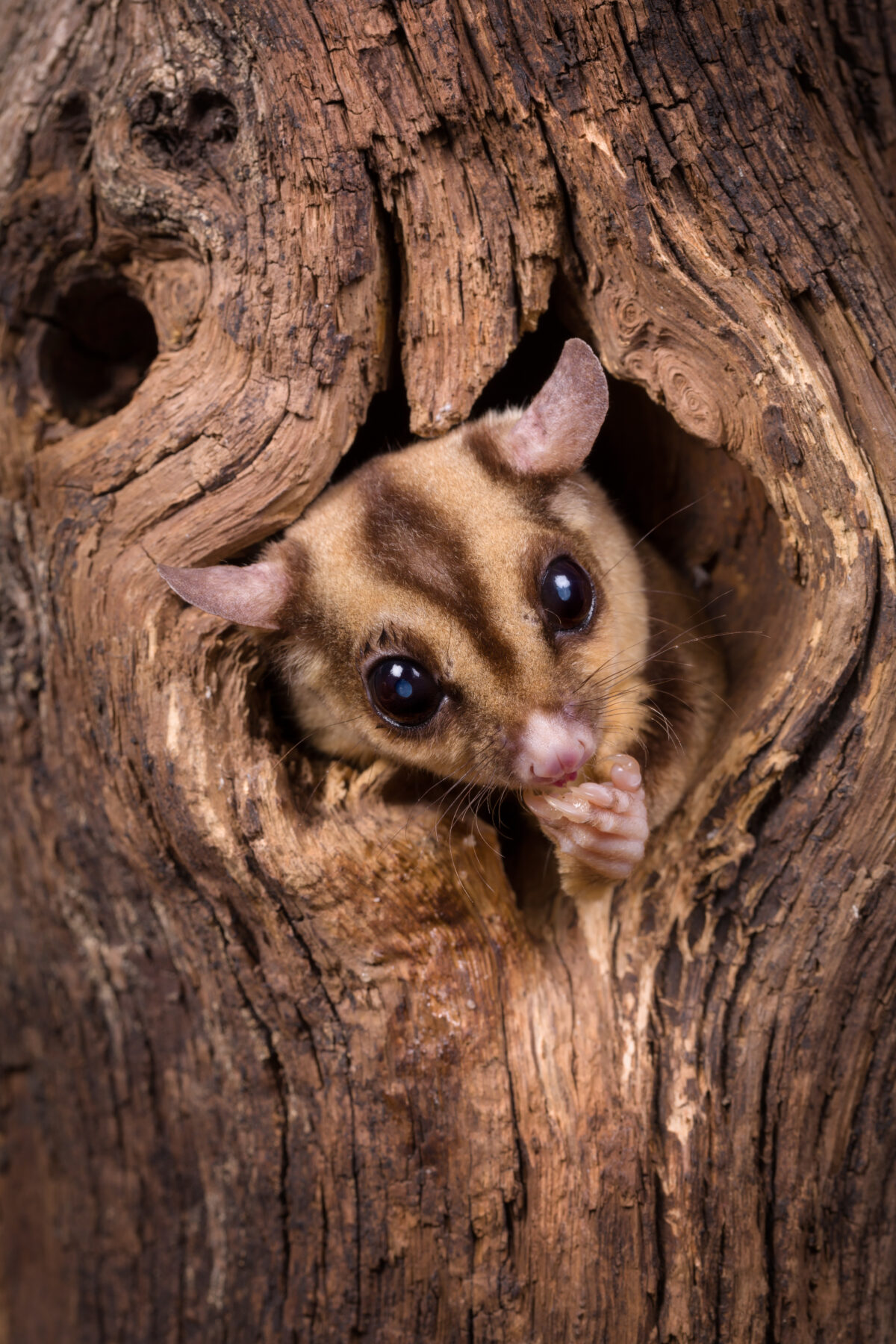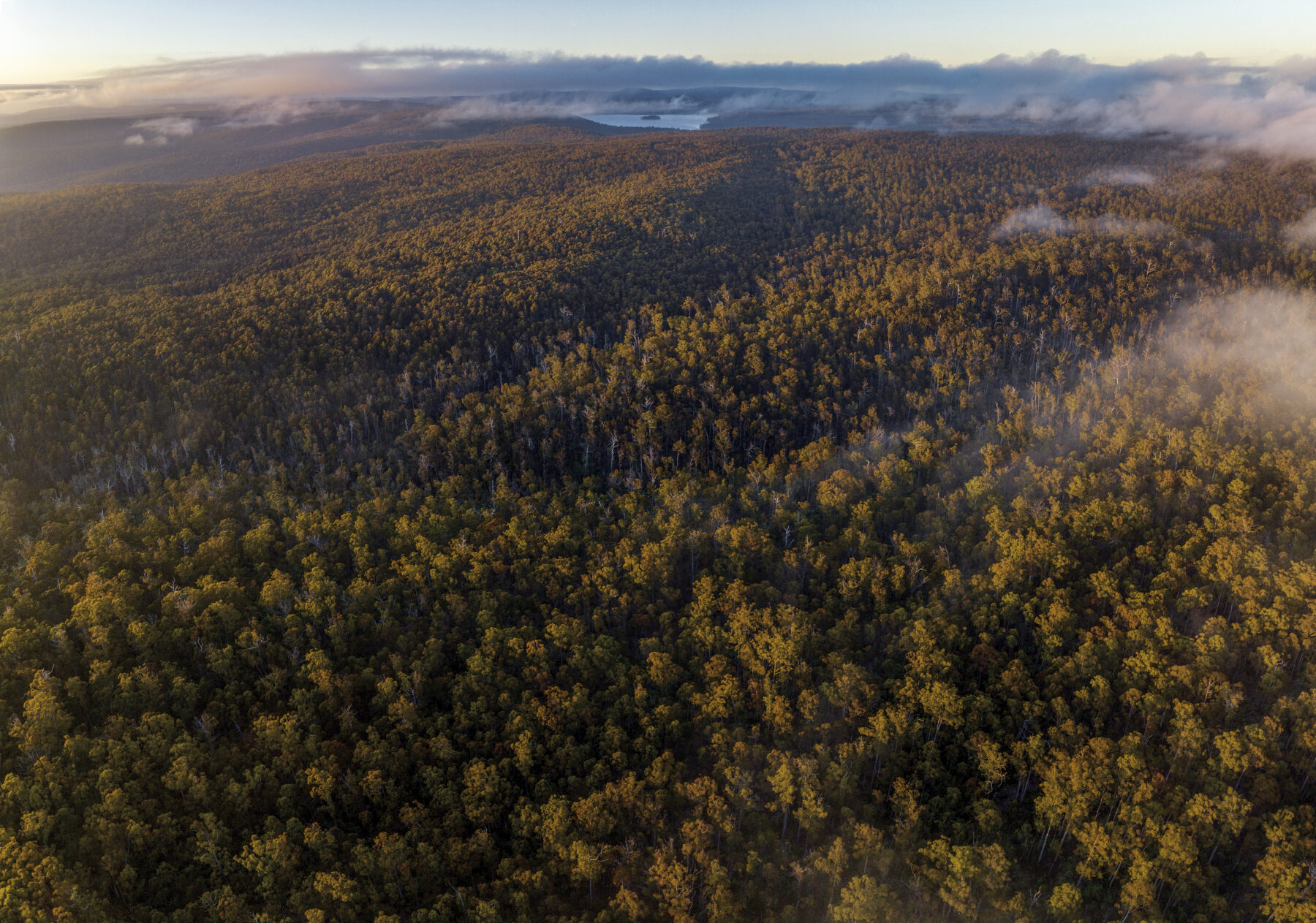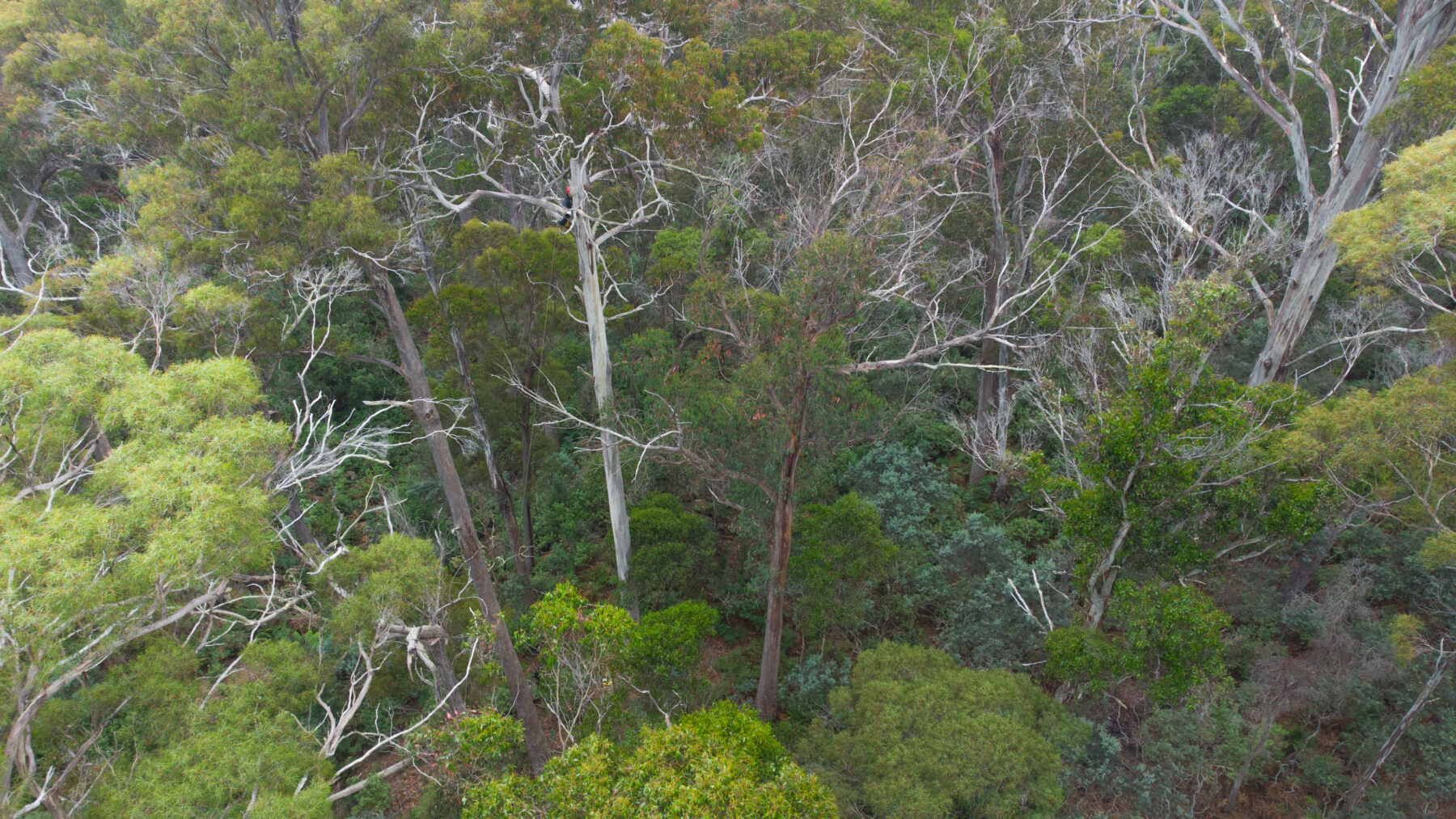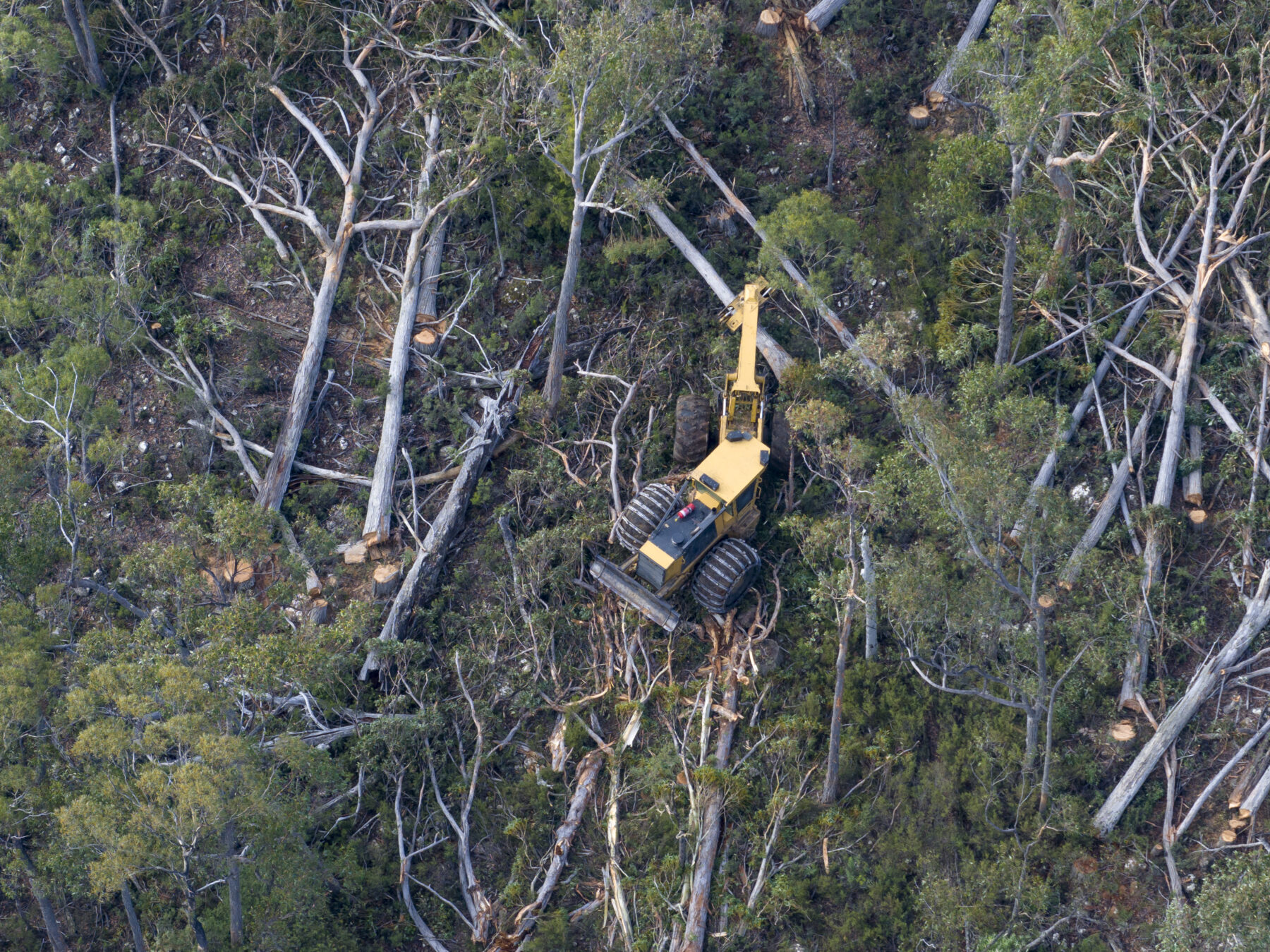Out on a limb: Here’s why we need to act swiftly to save this colourful character

Did Rob Blakers climb trees as a child? He says no.
Well.
Grew up in Canberra: “Had a reserve out the back of our place, and we had cubby houses up in trees, with nailed-in planks as ladders, to make steps. There were several trees that leant themselves to these grandiose cubbies we built up there.”
But that wasn’t real climbing, he says.
Three years ago, Rob Blakers, then aged 62, decided to learn how to climb trees, specifically the very tall and straight Tasmanian blue gum (Eucalyptus globulus). A pretty big community of tree-climbers in Tasmania, some he knew: they were happy to help.
A highly technical business, really. No mad clambering and hoping for the best. Rob learnt how to use ropes and a harness and how to get up and move about, 15–25 metres in the air, standing on branches, looking for a comfortable nook to nestle into, a place to feel secure, be it raining or not. A truer sense of security comes from checking and re-checking your procedures (as a pilot does before take-off) because to fail, and to fall, is to die. All of this he took to heart and mind. And so, for the last three summers Rob has stood up in the branches of blue gums, holding a camera with a lens the size of a rocket launcher. It was possible to swing around on a harness, to get a better position, but sitting in a harness for eight hours at a time is hard on the body and, really, you’re in better stead when holding on to that tree.
The point of this exercise was to photograph the world’s fastest parrot. How many people have even heard of such a thing? They’ve been clocked, the swift parrot, at nearly 90 kilometres an hour, the escape velocity of a car leaving the city and finding the open road.
Plenty of cars out there. So many cars.
Not so many swift parrots, less than 1000 remaining in the wild.
It’s a common story (species decline) that flares up in the public imagination too rarely and ineffectually: species edged out of, or suffering the destruction of, the kind of country it evolved from, where it once best fit. Habitat. It’s about as bad for the swift parrot as it can get without its genetics forever winking out as yet: officially listed as critically endangered. Critical condition like you hear about in car crashes. Doesn’t make the news as often.
It is possible that you have seen or heard in the winter a swift parrot in southern or central Victoria, or eastern New South Wales. They’re loud and busy. You can hear them above a chainsaw. Rob has a recording of a forestry chainsaw starting up and an insistent swift parrot very quickly registering its disquiet, dismay, distress: if only the parrot could speak for itself.
In the last weeks of winter the swift parrot heads south, crossing the high-reaching waters of Bass Strait, to breed among the flowering blue gums, over spring and into summer in the south-west or Eastern Tiers of Tasmania.
Beyond that, they exist nowhere else in the world.

All young men tend to fall in love, sooner or later, and Rob fell in love with the alpine region, notably Mount Kosciuszko. At the tail-end of a science degree, he elected to do a Honours project on the Bogong moth. Perhaps because they liked the alpine regions too. This was 44 years ago.
Back then, in the spring, billions of these moths flowered from beneath the soil of the floodplains in western NSW and southern Queensland, and undertook long migrations to shelter in the cool air of the alps. Some of these journeys were more than 1000km, and so spectacular in scale as to block out the moon and smother Parliament House.
The Rob Blakers project was mapping the moths’ aestivation sites. Aestivating is a neat trick: where the breeding cycle of a species is retarded to ensure they don’t breed in hostile conditions. For the Bogong moth, this means waiting out the summer. That’s the point of the migration. During the heat, the moths inhabit the high-country caves and the cracks in the granite outcrops.
“They just hang there, billions of them, like tiles: pull one at the bottom and two hundred will come down,” says Rob.
“On fine evenings, a portion will come out and whirl around your head for 20 minutes, banging into your head, and then they return to their caves. They’re not feeding. No one knows why they do it.”
For 2000 years, Indigenous people ate and toasted the Bogong moth, which was full of fat and protein. They might continue to feed the mountain pygmy possum if both creatures weren’t in such deep trouble. The latter is red listed as critically endangered (same as the swift parrot and orange-bellied parrot). The Bogong moth too has declined to the point of invisibility. In December 2021, it was listed as endangered on the global red list of threatened species. It was among 124 new entries on the list for Australian wildlife. It was thought that 99.5 per cent of the Bogong population had winked out three years before, due to pesticides, drought and light pollution.
In fact, numbers began to fall in the 1980s, soon after Rob had lived among the moths in beautiful summer.
“When I got to know them, they weren’t a conservation issue,” he says. “What’s happened to them since is the biggest bloody tragedy in the universe: they’ll be extinct in the wild in a matter of years. It just breaks my heart. These are the trends now, for shorebirds, most birds and wildlife: all those forces that are smashing shorebirds or Bogong moths aren’t stopping.”
And now here he is, witness to another (deleted) tragedy, climbing trees to photograph swift parrots in the canopy and at the nest, documenting the bird’s loud and joyful breeding ecology in areas of forest that were slated to be logged. These often intimate photographs were then published in a book, along with photographs of the inherent catastrophe of many Tasmanian blue gums chopped down and the ugly emptiness of what’s left behind. The idea was to use the book to lobby for an end to logging of these trees that the parrots rely on for their ongoing survival. Taken together it’s obviously depressing and, even sadder to say, probably futile.
Rob Blakers learned to climb the giants blue gums of Tassie to be able to photograph swift parrots.
But the time spent with the swift parrots was beautiful. As it was with the Bogong moth four decades ago, Rob got to know the swift parrots, and to some extent, always partially concealing themselves behind a curtain of leaves, the parrots got to know him. At the least they got to know he was there and weren’t obviously fussed.
“They are aware of me,” he says. “But I’m 20m away from the nest, so I’m not close at all. But with a long lens it’s not an issue,” and then:
“If you spend time watching wildlife you get to know them and detect patterns and behaviours. They’re very social birds and quite voluble when flying around tchu! tchu! tchu! But when they come to nest, you might hear them a 100m away but then they go silent. They’ll jump or fly silently to the top of a nearby branch, silently hop down the branch, then regurgitate and feed the mate or the chicks, and then fly away silently.
“In the second half of the summer, I was looking at a breeding pair and the behaviours as the offspring went from eggs to tiny young to fledglings and then out. The two adults, their behaviour changes through that time. Initially the female sits on the eggs and the male is the one getting the food, and will come and perch on a nearby branch or else go into the nest and regurgitate the food into the female (sitting on the eggs at that time).
“Then once the chicks have hatched the male will go into the nest and regurgitate (the nectar) and feed the chicks. Once the chicks get a little bit bigger they’ll start coming out to the edge of the nest and the male will perch on the edge of the nest and regurgitate – at that point both male and female will be out getting food.
“And one place last summer where I got most of the photos from wasn’t even a nest, it was a wooden spar, a dead spar coming out the top of a living tree, extending above the canopy. I think they used it as a hangout and a lookout. And when they’re wet, it’s a place to dry off. They come and sit on this spar (somewhat like cormorants do) and preen themselves like crazy for 20 minutes and disappear again. It happened repeatedly in the rain.”
Rob Blakers is one of four siblings and it’s been a long time since they sat in those cubby houses, yet they all retain an interest in nature, and all love bushwalking. Margaret Blakers OAM, the eldest of the four, is credited for establishing the Victorian Greens and the national environmental policy of the Australian Greens, was an adviser to Senator Bob Brown, worked on the first Australian bird atlas, and continues on as a champion for forests. She, too, like her brothers, used to explore the nature reserve at the back of the Blakers family home in Canberra. This was in the 1960s. The idea of finding such an array of bird and plant and insect species on one’s suburban doorstep today is laughable if you’re prone to dark humour. It was beautiful while it lasted.
“The neighbourhood kids would all go there,” says Rob, “roaming around the woodland. It was fantastic.”
But how do you go from frolicking as a child to giving your life over to a cause?
“My parents were really good people. Mother was a teacher, Father a senior public servant. And in those days it was old-style service. My father wasn’t out there to make a big career. He got quite high (in the public service) but that wasn’t his intention: he just dedicated his whole life to service. That’s what it was then.”
Young Rob Blakers thought he was following the same path: he was applying for jobs in the department of statistics. “My whole mindset was pretty conventional,” he say, “trusting of governments.”
Before following this desk-bound calling in earnest, he went to Tasmania for a three-week holiday. “I’d just finished university, I was 22 years old and I was free.”

He’d planned to spend the time cross-country skiing. “But there was no snow. So I wandered into the Wilderness Society and became politicised. This was a couple of years leading up to the blockade (of the proposed Franklin River dam). So I was caught in this vortex. Three weeks got extended to a month, two months and a year later I realised I was living in Tassie with this amazing bunch of young people. It turned me my whole framework around. I was working with Bob Brown and took on his approach. There was this whole gang of 15 people, Bob was a bit older, all on the dole, all working 16-hour days, doing nothing else, and we didn’t know that we were up against everything, all levels of government, media, unions and half of the public in Tassie. We sort of went ahead because we knew it was right. I think something like 1500 went to jail. But they turned it around. It was a miracle.”
Rob, who made his name as a landscape photographer during the Franklin campaign, was one of the people jailed. It was a big deal then, being arrested and jailed for a cause. It was even a bigger deal that the campaign worked, the Franklin was saved. “Our experience was that you do a campaign and it works. Over the next 30 years I’ve done so many campaigns that haven’t worked: losing forests to mines or logging in particular.”
In late June, the Bob Brown Foundation put out a press release. It began:
“One of Tasmania’s most renowned wilderness photographers, Rob Blakers, has been arrested by police after refusing to leave an area of critically endangered swift parrot habitat being destroyed in Tasmania’s Eastern Tiers.”
Where’s the outrage? Where is the media interest?
By then, Rob’s book of photographs was published. He’d been hoping to meet politicians and bureaucrats, do some lobbying. A couple of weeks before he was arrested, he told Australian Geographic:
“My job and our job is to bring pressure: they can’t sweep this under the rug because the bird will go extinct.”

default 
default
Cute and deadly

Chainsaws and the loss of breeding habitat aren’t only cause of ruination for swift parrots. While the parrots carefully choose a snug-fitting tree hollow for nesting, to keep out predators, the cute but deadly sugar glider (Petaurus breviceps), a species introduced into Tasmania in the 19th Century, manages to work its way into the hole, trapping, killing and eating the mother and eggs.
“The consequence,” says Rob Blakers, “is an imbalance in the sex of the swift parrot population: there are far more males and far fewer females, which is exacerbating the decline.”
Further, the sugar gliders essentially work in tandem with logging. “The biggest predictor of sugar glider predation and nest mortality,” says Rob, “is the integrity of the forest.”
In other words, if the forest is fragmented or compromised, via logging, the gliders tend to do better. “They feed on insects and nectar and not just swift parrots.”
Pro-logging governments have somewhat opportunistically highlighted the glider threat, intimating it as the main cause of swift parrot decline.
In 2018, the Office of the Premier of Tasmania, put out a press release advising:
“It is estimated that up to 85 per cent of the critically endangered swift parrot population is at potential risk each season of being killed by sugar gliders.
“Research has shown that sugar gliders can have a devastating impact on swift parrot breeding success, with statistics showing 79 per cent of nests and 65 per cent of breeding females on mainland Tasmania can fall victim to sugar gliders each year.
“Following this revelation, the Commonwealth Government changed the listing of the swift parrot from ‘endangered’ to ‘critically endangered’ in 2016.”
This was part of an announcement that $150,000 would be spent trapping sugar gliders in 80 nesting boxes in Tasmania, “effectively creating safe zones for swift parrots to breed”.
There was no mention of limiting or ceasing the logging of Tasmanian blue gums.
Image credit: Shutterstock













